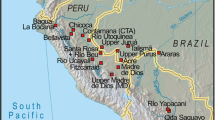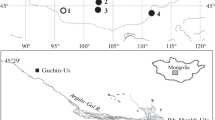Abstract
During the last two decades, studies in central Asia, and mainly in Inner Mongolia, have greatly improved our understanding of the palaeontology, biochronology, and environmental changes across the Palaeocene–Eocene transition in the region. Among numerous fossil mammals, discoveries of important taxa of perissodactyls, lagomorphs, rodents, and primates provide additional age calibrations for mammalian divergences, and indicate that several placental mammal orders emerged at the beginning of the Eocene. These recently reported species provide important morphological features that help to understand the evolution of their lineages. Collectively, the faunal compositions show that mammalian faunal evolution in central Asia was probably affected by global environmental changes across the Palaeocene–Eocene transition.
Access provided by Autonomous University of Puebla. Download conference paper PDF
Similar content being viewed by others
Keywords
Introduction
Central Asia has extensive continental Palaeogene sediments and rich vertebrate fossils. Since the work of the Central Asiatic Expedition of the American Museum of Natural History in the 1920s, the Tertiary deposits and mammal faunas of this region have formed the basis for most of the Asian Land Mammal Ages (ALMAs) of the Palaeogene (Russell and Zhai 1987). Mammalian evolution and faunal turnover patterns have been recognized (Meng and McKenna 1998; Tsubamoto et al. 2004; Wang et al. 2007) that are largely correlative to global environmental changes recognized from marine records (Zachos et al. 2001). However, because of the lack of systematic fossil-collecting and age constraints independent of mammalian evolution, the Palaeogene ALMAs are not well calibrated and the correlations of geological and evolutionary events are not well established.
In the past two decades, extensive fieldwork has been conducted in central Asia, mainly in the Erlian Basin of Inner Mongolia and northern Junggar Basin of Xinjiang, China, and the southern Gobi of Mongolia. These include detailed stratigraphic work and systematic fossil-collecting as well as magnetic and isotope sampling at the classic localities and some new sites in these areas. With the new data, we are able to resolve a series of stratigraphic and locality uncertainties and errors accumulated since the 1920s, so that rock units containing faunas for some ALMAs (e.g., Gashatan, Bumbanian, Arshantan, and Irdinmanhan) can be more accurately redefined, subdivided, and correlated (Meng et al. 2007b; Wang et al. 2010). In particular, these new data greatly improve our understanding of the Asian continental Palaeogene and, in particular, of the Palaeogene–Eocene transition in the region in terms of palaeontology, biochronology, and environmental changes.
Results and Discussion
Our results show that the late Palaeocene Gashatan fauna is dominated by archaic forms, such as Pseudictops, Prodinoceras, and the multituberculate Lambdopsalis and Prinessus, but these forms became extinct at the end of the Palaeocene. At the beginning of the Eocene, several placental mammal orders made their first appearances. From the lowermost Eocene Bumbanian beds, two species of perissodactyls have been discovered: the lophialetid tapiroid Minchenoletes erlianensis and the hyracodontid rhinocerotoid Pataecops parvus. These two species extend the fossil records of the Lophialetidae and the Rhinocerotoidea to the earliest Eocene (Wang et al. 2011). Also occurring in the Bumbanian faunas are the primate Baataromomys ulaanus (Ni et al. 2007), the rodent Yuanomyszhoui (Meng and Li 2010), the stem lagomorph Gomphos elkema (Meng et al. 2004), and a possible lagomorph (Wang et al. 2010).
After the initial evolutionary pulse at the beginning of the Eocene, mammals started to diversify and flourish in the early–middle Eocene, with perissodactyls being the dominant large-bodied species (Wang et al. 2010). Of the taxa discovered in recent years, the following are of particular importance. The basal chalicothere Litolophus (Bai et al. 2011) presents the ungual morphology that demonstrates the transformation from perissodactyl hooves to claws in chalicotheres. The earliest known lagomorph Dawsonolagus antiquus, which is represented by some cranial and postcranial material, shows a mosaic combination of features similar to mimotonids and lagomorphs, and thus represents a morphotype intermediate between the Palaeocene mimotonids and typical lagomorphs (Li et al. 2007). In addition to the Bumbanian ctenodactyloid rodent Yuanomys zhoui, the dental morphology of the peculiar rodent Archetypomys also shows features derived from the late Palaeocene alagomyids, such as Tribosphenomys (Meng et al. 2007a), which casts new light on the origin and early evolution of rodents. The myodont rodent Erlianomys combinatus (Li and Meng 2010) represents the earliest member (~54 Ma) of the crown rodents displaying the primitive cricetid tooth plan, from which the dental pattern of muroids and dipodoids may be derived. Finally, the middle Eocene omomyid Tarkops from the Irdin Manha Formation confirms the coexistence of tarkadectine primates in Asia and North America and suggests that similar palaeoenvironmental conditions appropriate to sustain primates applied during the middle Eocene (Ni et al. 2009).
Because most of the specimens collected in the last two decades have better magnetostratigraphic constraints than was previously the case, they have served as additional age constraints in the search for mammalian divergence times. For instance, the possible lagomorph in the lowermost Eocene Bumbanian beds (Wang et al. 2010) has been used as the earliest record of the group (O’Leary et al. 2013), and Erlianomys was used as a new calibration point in a molecular clock study focused on rodent divergence times (Wu et al. 2012). Both previous studies and our own analyses support a post-K–Pg divergence of the placental mammals, with several orders developing at the beginning of the Eocene.
Our studies also lend additional support to the notion that faunal evolution across the Palaeocene–Eocene transition in central Asia was characterized by the extinction of ancient groups such as Pseudictops and Prodinoceras and multituberculates at the end of the Palaeocene (Meng and McKenna 1998). Then, several modern mammalian orders emerged abruptly at the beginning of the Eocene, an emergence that was probably related to the extreme climatic warming during the Palaeocene–Eocene thermal maximum; the highly diversified early–middle Eocene mammal faunas probably reflect the favourable conditions of the early Eocene climatic optimum (Wang et al. 2010).
References
Bai, B., Wang, Y.-Q., & Meng, J. (2011). Early Eocene chalicothere Litolophus with hoof-like unguals. Journal Vertebrate Paleontology,31, 1387–1391. http://dx.doi.org/10.1080/039.031.0615
Li, Q., & Meng, J. (2010). Erlianomys combinatus, a primitive myodont rodent from the Eocene Ashanto Formation, Nuhetingboerhe, Nei Mongol, China. Vertebrata PalAsiatica,48, 133–144.
Li, C-k, Meng, J., & Wang, Y.-Q. (2007). Dawsonolagus, a primitive lagomorph from the Eocene Arshanto Formation, Inner mongolia. China Bulletin of the Carnegie Museum,39, 97–110.
Meng, J., & McKenna, M. C. (1998). Faunal turnovers of palaeogene mammals from the mongolian plateau. Nature,394, 364–367.
Meng, J., & Li, C.-K. (2010). New rodents from the earliest Eocene of Nei mongol (Inner Mongolia), China. Vertebrata PalAsiatica,48, 390–401.
Meng, J., Bowen, G. J., Ye, J., Koch, P. L., Ting, S.-Y., Li, Q., et al. (2004). Gomphoselkema (Glires, Mammalia) from the Erlian Basin: Evidence for the early tertiary bumbanian land mammal age in nei-mongol. China American Museum Novitates,3425, 1–24.
Meng, J., Li, C.-K., Wang, Y.-Q., & Ni, X.-J. (2007a). A new Eocene rodent from the lower Arshanto Formation in the Nuhetingboerhe (Camp Margetts) area. Inner Mongolia American Museum Novitates,3569, 1–18.
Meng, J., Wang, Y.-Q., Ni, X.-J., Beard, K. C., Sun, C.-K., Li, Q., et al. (2007b). New Stratigraphic data from the Erlian Basin: Definitions, divisions and correlations of Paleogene stratigraphic units in Inner Mongolia. American Museum Novitates,3570, 1–31.
Ni, X.-J., Beard, K. C., Meng, J., Wang, Y.-Q., & Gebo, D. L. (2007). Discovery of the first early Cenozoic euprimate (Mammalia) from Inner Mongolia. American Museum Novitates,3571, 1–11.
Ni, X.-J., Meng, J., Beard, K. C., Wang, Y.-Q., Gebo, D. L., & Li, C.-K. (2009). A new tarkadectine primate from Inner Mongolia. China Proceedings of the Royal Society B,277, 247–256.
O’Leary, M. A. et al. (2013). Phylogenetic reconstruction of the post K-Pg placental ancestor and a transformation of phylophenomics. Science 339, 662-667.
Russell, D. E., & Zhai, R.–J. (1987). The Paleogene of Asia: Mammals and stratigraphy. Mém Mus Natl d’Hist Nat Sér C-Sci Terre 52, 448.
Tsubamoto, T., Takai, M., & Egi, N. (2004). —Quantitative analyses of biogeography and faunal evolution of Middle to Late Eocene mammals in East Asia. Journal of Vertebrate Paleontology, 24, 657–667.
Wang, Y.-Q., Meng, J., Ni, X.-J., & Li, C.-K. (2007). —Major events of Paleocene mammal radiation in China. Geological Journal,42, 415–430.
Wang, Y.-Q., Meng, J., Beard, K. C., Li, Q., Ni, X.-J., Gebo, D. L., et al. (2010). Early Paleogene stratigraphic sequence, mammalian evolution and its response to the environmental change in Erlian Basin, Nei Mongol, China. Science China, Geology,40, 1277–1286.
Wang, Y.-Q., Meng, J., Jin, X., Beard, K. C., Bai, B., Li, P., et al. (2011). —Early Eocene perissodactyls (Mammalia) from the upper Nomogen Formation of the Erlian Basin, Nei Mongol, China. Vertebrata PalAsiatica,49, 123–140.
Wu, S.-Y., Wu, W.-Y., Zhang, F.-C., Ye, J., Ni, X.-J., Sun, J.-M., et al. (2012). —Molecular and paleontological support for a post-Cretaceous origin of rodents. PLoS ONE,7(10), e46445. doi:10.1371/journal.pone.0046445.
Zachos, J. C., Pagani, M., Sloan, L. C., Thomas, E., & Billups, K. (2001). —Trends, rhythms, and aberrations in global climate 65 Ma to present. Science,292, 686–693.
Author information
Authors and Affiliations
Corresponding author
Editor information
Editors and Affiliations
Rights and permissions
Copyright information
© 2014 Springer-Verlag Berlin Heidelberg
About this paper
Cite this paper
Meng, J., Wang, Y. (2014). Mammalian Evolution Across the Palaeocene–Eocene Transition in Central Asia. In: Rocha, R., Pais, J., Kullberg, J., Finney, S. (eds) STRATI 2013. Springer Geology. Springer, Cham. https://doi.org/10.1007/978-3-319-04364-7_24
Download citation
DOI: https://doi.org/10.1007/978-3-319-04364-7_24
Published:
Publisher Name: Springer, Cham
Print ISBN: 978-3-319-04363-0
Online ISBN: 978-3-319-04364-7
eBook Packages: Earth and Environmental ScienceEarth and Environmental Science (R0)




